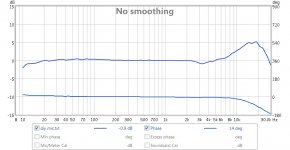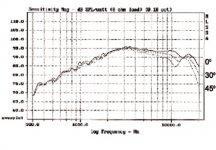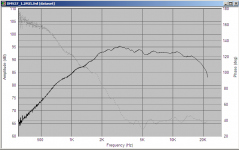one of my friends has a "Dayton Audio OmniMic V2 Precision Measurement System" I used it some time now I want my own system. I want your idea about Mic and software... what about Behringer ECM8000? what is the best software for speaker measurement?  I want measure T/S and analyze speakers response and sensitivity and so on
I want measure T/S and analyze speakers response and sensitivity and so on 
Last edited:
#1. When you buy the mic, BY ONE CAIBRATED. I am not kidding.
The ECM8000 is what we all have. You of course need a mic preamp with phantom power. I have M-audio external mic preamp and sound card, one Firewire, one USB. The e-mu 1616m kept crashing. Want one cheap?
I use several tools. Some cost, some free. If I use the free one as part of my standard kit, I make a donation.
Electrical:
I have the older WT-2 for impedance measurement. Great tool. It does everything you need for T/S measurements. I think it is Woofer Tester III now. I would not be without it.
Acoustic:
ARTA is a great package.( free) I am kind of converting to it even though I own the very powerful do everything measure and model everything SoundEasy package.(expensive) I still prefer TrueRTA in the paid 1/24 octave version for bass/box measurements. I know it and it is easy.
Simulation:
The EDGE is quite handy. I model electrical stuff in Spice. WinISL for box design and several spreadsheets of my own for crossovers and unit conversions..
Download the ARTA manual, and the SoundEasy manual. Read all about how to do the measurements before you spend money. ALso, read Joe D'Appolito's book Measuring Loudspeakers. None of this will makes sense unless you learn what you are really measuring.
Did I mention you only want to buy a calibrated mic?
A good lab is not cheap. You will also eventually want an LCR meter and decent DVM. I use a dedicated integrated amp on my bench with a Behringer DCX. I still use an old pulse generator from a kit for measuring time delays and phase offsets. You need a delayed trigger scope to use it. Zelscope sort of does, but I use my old Tek bench scope. I have the old school tools too, HP signal generator, AC voltmeter, counter, etc. e-bay is your friend.
PS: If you don't buy a calibrated mic, you will have to have yours calibrated eventually anyway.
The ECM8000 is what we all have. You of course need a mic preamp with phantom power. I have M-audio external mic preamp and sound card, one Firewire, one USB. The e-mu 1616m kept crashing. Want one cheap?
I use several tools. Some cost, some free. If I use the free one as part of my standard kit, I make a donation.
Electrical:
I have the older WT-2 for impedance measurement. Great tool. It does everything you need for T/S measurements. I think it is Woofer Tester III now. I would not be without it.
Acoustic:
ARTA is a great package.( free) I am kind of converting to it even though I own the very powerful do everything measure and model everything SoundEasy package.(expensive) I still prefer TrueRTA in the paid 1/24 octave version for bass/box measurements. I know it and it is easy.
Simulation:
The EDGE is quite handy. I model electrical stuff in Spice. WinISL for box design and several spreadsheets of my own for crossovers and unit conversions..
Download the ARTA manual, and the SoundEasy manual. Read all about how to do the measurements before you spend money. ALso, read Joe D'Appolito's book Measuring Loudspeakers. None of this will makes sense unless you learn what you are really measuring.
Did I mention you only want to buy a calibrated mic?
A good lab is not cheap. You will also eventually want an LCR meter and decent DVM. I use a dedicated integrated amp on my bench with a Behringer DCX. I still use an old pulse generator from a kit for measuring time delays and phase offsets. You need a delayed trigger scope to use it. Zelscope sort of does, but I use my old Tek bench scope. I have the old school tools too, HP signal generator, AC voltmeter, counter, etc. e-bay is your friend.
PS: If you don't buy a calibrated mic, you will have to have yours calibrated eventually anyway.
I have a Blue Icicle mic preamp that provides phantom power, mic preamp and usb output. It seems to work really well and it's fairly inexpensive.
https://www.bluemic.com/icicle/
https://www.bluemic.com/icicle/
thanks to all entries 
I don't want sell my car to buy a lab... I just want something to work for some years and then maybe I'll get something more accurate
how about Dayton Audio OmniMic V2 Precision Measurement System with about US$300.00? is there any better option at this price?
I don't want sell my car to buy a lab... I just want something to work for some years and then maybe I'll get something more accurate
how about Dayton Audio OmniMic V2 Precision Measurement System with about US$300.00? is there any better option at this price?
one of my friends has a "Dayton Audio OmniMic V2 Precision Measurement System" I used it some time now I want my own system. I want your idea about Mic and software... what about Behringer ECM8000? what is the best software for speaker measurement?I want measure T/S and analyze speakers response and sensitivity and so on

I have enough experience measuring loudspeakers and designing crossovers to put in my response here. I suggest you get the following:
- calbrated microhpone
- microphone preamp with phantom power
- measurement software
I use the ARTA suite of measurement software extensively (ARTA Home). They offer a free version that does everything you need, but it wouldn't be bad to pay them if you like it. This does everything you will need for making loudspeaker measurements, and I wrote a tutorial about how obtain a quasi-anechoic frequency response using a gated impulse measurement (See: http://audio.claub.net/tutorials/FR measurement using ARTA.pdf) since this is an important part of taking measurements. Don't worry about phase measurements - you can just extract the minimum phase from the frequency response. Again, this is pretty standard for loudspeaker measurement and crossover design.
There are several ways to measure T/S parameters, including the LIMP module of ARTA. By far the easiest way to measure T/S parameters is with a "woofer tester". I use the Smith and Larson WT2 version, because it is reliable. There is also a WT3 sold by Parts-Express that is fancier and faster. Both of these allow you to just connect the driver to the computer via a small external box (sold with the product) and take the measurements quickly and easily.
That will get you started. There are certainly a few other things to be learned about loudspeaker measurements, but you need to crawl before you run.
-Charlie
Last edited:
Ditto the above. The Behringer or Dayton Mic and a USB soundcard. I use M-Audio.
The Dayton Omni mic is nice and the software is very good and is an integrated package. ARTA, as stated is very good and so is HOLMImpulse.
The WT3 is very fast and easy to use for T/S parameters.
That's all you need, really.
The Dayton Omni mic is nice and the software is very good and is an integrated package. ARTA, as stated is very good and so is HOLMImpulse.
The WT3 is very fast and easy to use for T/S parameters.
That's all you need, really.
1. Dayton Audio DATS Dayton Audio Test System 390-806
You *could* dump DATS.. but practically speaking it's a "no-brainer" for a fast and easy method for obtaining T/S param's with impedance - with the ability to export to a more sophisticated software suite like Soundeasy. The OmniMic won't do this for you.
2. Dayton Audio EMM-6 Electret Measurement Microphone Allows For Accurate Acoustic Measurements At A Fraction Of The Price 390-801
NOTE: once purchased you download the calibration file.
3. Amazon.com: ART USB Dual Pre: Musical Instruments
IF using Windows 7:
ART Pro Audio
Basically 2 & 3 along with "freeware" software nets you your equivalent to the OmniMic, though also has the capability for 2 mics (should you choose to add an additional one). (..note the difference in cost vs. the OmniMic.)
IF it's just speaker measurement then HOLM or ARTA will have you covered for "free".
IF you want speaker design software INTEGRATED then Soundeasy.
You *could* dump DATS.. but practically speaking it's a "no-brainer" for a fast and easy method for obtaining T/S param's with impedance - with the ability to export to a more sophisticated software suite like Soundeasy. The OmniMic won't do this for you.
2. Dayton Audio EMM-6 Electret Measurement Microphone Allows For Accurate Acoustic Measurements At A Fraction Of The Price 390-801
NOTE: once purchased you download the calibration file.
3. Amazon.com: ART USB Dual Pre: Musical Instruments
IF using Windows 7:
ART Pro Audio
Basically 2 & 3 along with "freeware" software nets you your equivalent to the OmniMic, though also has the capability for 2 mics (should you choose to add an additional one). (..note the difference in cost vs. the OmniMic.)
IF it's just speaker measurement then HOLM or ARTA will have you covered for "free".
IF you want speaker design software INTEGRATED then Soundeasy.
Last edited:
Charlie,Don't worry about phase measurements - you can just extract the minimum phase from the frequency response.
-Charlie
After decades of using RTAs to assist in working out proper crossover response, using SMAART, which has magnitude and phase response has made crossover alignment much more predictable (i.e better sounding, flatter phase & magnitude (amplitude) response) and quicker to do.
How do you extract the minimum phase from just the frequency response?
Art
Although clunky, REW is top notch. Send a donation once you get the hang of itBetter than Holm and Arta IMO.
After years of using speaker workshop for doing T/S measurements I just recently tried out REW and it is very good. The latest woofers just did not measure properly with SW but REW worked well. I tried ARTA and it seemed ok but didn't like my soundcard, continuously giving clicks and pops whilst doing the sine sweep.
My last project all impedance measurements were done in Speaker Workshop, and all acoustic measurements were done with holm impulse, exported and imported into speaker workshop for crossover modelling.
I successfully designed the crossover using simulation of the measured drivers and the implemented version matched the sims very closely. All software free.
I do not have a calibrated mic (it's a panasonic WM-60AY which are quite flat) But if you can get calibrated for a decent price then all the better. My preamp is based on Eric Wallins preamp II design.
edit: oh and make yourself a speaker testing stand
Tony.
Last edited:
thanks to all replies
one of my friend is in California right now. I told him to buy the microphone for me. I want to buy two mics because there is no such a microphone in my place and I'll save one for rainyday . I want to know which buy would be the best, one Dayton Audio EMM-6 + one Behringer ECM800 or two Dayton Audio EMM-6?
. I want to know which buy would be the best, one Dayton Audio EMM-6 + one Behringer ECM800 or two Dayton Audio EMM-6?
one of my friend is in California right now. I told him to buy the microphone for me. I want to buy two mics because there is no such a microphone in my place and I'll save one for rainyday
I do not have a calibrated mic (it's a panasonic WM-60AY which are quite flat) But if you can get calibrated for a decent price then all the better. My preamp is based on Eric Wallins preamp II design.
I can't speak for the WM-60AY, but I have a diy mic based on the WM-61A that I recently had calibrated. Here's the measurement that was taken during the calibration process. Not exactly flat.
I was using a generic cal file for it I found online. For a while I forgot to enable it in ARTA, and I wondered why my speakers were harsh and fatigueing to listen to. That 5db rise on the top end wasn't doing me any favors. For a minute I thought they sounded "more realistic"
I went the diy route for the mic initially to save $$. With the power source I had to put together for it, the couple capsules that I damaged trying to build it, the calibration service, and the headaches I had from the process I may as well have gotten one from Cross Spectrum and been done with it.
Attachments
I want to know which buy would be the best, one Dayton Audio EMM-6 + one Behringer ECM800 or two Dayton Audio EMM-6?
They are essentially the same mic, HOWEVER:
The Dayton Mic has:
1. access to a calibration file at no charge (for that particular mic)
2. a slightly lower cost.
Result: 2 Dayton Mic's; no Behringer Mic.
NOTE: the mic's need phantom power.
That Art Audio USB DAC that I posted a link to was the least expensive DAC + Phantom power solution that I could find that had TWO phantom power mic inputs AND generally worked with any OS.
IF you already have a DAC for your computer with mic input - then chances are that it does NOT have Phantom power nor is XLR based (..as virtually all good mic's have XLR out). HOWEVER there are solutions that provide JUST phantom power (and do NOT include a DAC), BUT you will need either one for each mic or a single unit with TWO XLR mic inputs. In either case (for those phantom power supplies), you will need a mini-jack (out) for your mic (in) on your computer's DAC. Additionally chances are that your computer's DAC doesn't have 2 mic inputs (though it should have another audio-in).
Long story short - get the Art Audio unit.
Last edited:
Can't tell, does that ART have line outs too? It looks like just monitor of the inputs. I use a Profire for my "good" measurements. I still have and need to auction an e-mu 1616m. Great system, but it crashes my PC. Does not seem to do that to everyone. I know it is a lot more money, but the FastTrack Pro has the features.
Can't tell, does that ART have line outs too? It looks like just monitor of the inputs.
I use a Profire for my "good" measurements. I still have and need to auction an e-mu 1616m. Great system, but it crashes my PC. Does not seem to do that to everyone. I know it is a lot more money, but the FastTrack Pro has the features.
It has:
1. 2 XLR with Phantom Mic in (..and variable gain for each), and
2. 1 stereo mini-jack out (..and variable gain for both channels - generally intended for headphone use), and
3. 2 phono out (usually L & R) balanced.
(..obviously you would need a phono to RCA adapter/cord for hook-up to a stereo amplifier. Alternatively you could use the headphone-out stereo mini-jack to a stereo mini-jack in IF the amplifier had that, or again with a stereo mini-jack to RCA adapter/cord.)
So yes, it has the features.
The only feature it doesn't have is a higher bit and sample rate - which really isn't necessary (and isn't even an option with some measurement software).
Again, it *also* seems to be a product that won't present problems with Windows 7 provided it's set correctly as a *stereo* unit in Windows 7 per the instructions on the manufacturer's website. It has also been reported to work with most modern full Linux distro's and Mac.
Last edited:
I can't speak for the WM-60AY, but I have a diy mic based on the WM-61A that I recently had calibrated. Here's the measurement that was taken during the calibration process. Not exactly flat.
I went the diy route for the mic initially to save $$. With the power source I had to put together for it, the couple capsules that I damaged trying to build it, the calibration service, and the headaches I had from the process I may as well have gotten one from Cross Spectrum and been done with it.
Yes I think that with the death of the WM-60AY, going with an uncalibrated mic probably went out the window. Just for the record below is the manufacturer's spec of my tweeter, and my own measurement (scaled to match the same relative level on the manufacturers spec) done with my uncalibrated wm-60ay mic. This is why I have never bothered to get the mic calibrated
Tony.
Attachments
This is why I have never bothered to get the mic calibrated
Tony.
Nice

Now maybe the op can scrounge some WM-60A's for a dirt cheap mic.
- Status
- This old topic is closed. If you want to reopen this topic, contact a moderator using the "Report Post" button.
- Home
- Loudspeakers
- Multi-Way
- Help in measuring speakers


